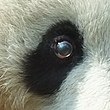Ailuropoda
| Panda | |
|---|---|

| |
| The giant panda, the only extant species in the genus and subfamily | |

| |
| Ailuropoda fovealis[clarification needed] skull | |
| Scientific classification | |
| Domain: | Eukaryota |
| Kingdom: | Animalia |
| Phylum: | Chordata |
| Class: | Mammalia |
| Order: | Carnivora |
| Family: | Ursidae |
| Subfamily: | Ailuropodinae |
| Genus: | Ailuropoda Milne-Edwards, 1870[1][2] |
| Type species | |
| Ailuropoda melanoleuca | |
| Species | |
Ailuropoda is the only extant genus in the ursid (bear) subfamily Ailuropodinae. It contains one living and three fossil species of panda.[4]
Only one species—
Giant pandas have descended from Ailurarctos, which lived during the late Miocene.[4]
Etymology

From Greek αἴλουρος aílouros "cat" + ‒ποδός ‒podós "foot" (gen. sg.). Unlike most bears, giant pandas do not have round pupils, but instead have vertical slits, similar to those of cats. This has not only inspired the scientific name, but in Chinese the giant panda is called "large bear cat" (大熊猫, dà xióngmāo).
Classification
- †Ailuropoda microta Pei, 1962[5][6] (late Pliocene)
- †Ailuropoda wulingshanensis Wang et alii. 1982[7] (late Pliocene - early Pleistocene)
- †Ailuropoda baconi (Woodward 1915)[8] (Pleistocene)
-
- Ailuropoda melanoleuca melanoleuca (David, 1869)
- Ailuropoda melanoleuca qinlingensis Wan Q.H., Wu H. et Fang S.G., 2005[9]
Other pandas
The red, or lesser, panda (Ailurus fulgens) was formerly considered closely related to the giant panda. It is no longer considered a bear, however, and is now classified as the sole living representative of a different carnivore family (Ailuridae).
References
- ^ Milne-Edwards, Alphonse (1870). "Note sur quelques mammifères du Thibet oriental". Annales des sciences naturelles, Zoologie. Ser. 5. 14 (10): 1.
- ^ Milne-Edwards, Alphonse (1870). "Note sur quelques Mammifères du Thibet oriental". Comptes rendus hebdomadaires des séances de l'Académie des sciences. 70: 341–342.
- ^ a b David, Armand (1869). "Voyage en Chine". Bulletin des Nouvelles Archives du Muséum. 5: 13.
Ursus melanoleucus
- ^ PMID 17578912.
- ^ Pei, Wen-chung (1962). "Guǎngxī liǔchéng jù yuán dòng jí qítā shāndòng de dì sì jì bǔrǔ dòngwù" 广西柳城巨猿洞及其他山洞的第四纪哺乳动物 [Quaternary Mammals from the Liucheng Gigantopithecus Cave and Other Caves of Kwangsi] (PDF). Vertebrata PalAsiatica. 6 (3): 211–218.
- ^ Pei, Wen-Chung (1963). "Quaternary Mammals From the Liucheng Gigantopithecus Cave and Other Caves of Kwangsi" (PDF). Scientia Sinica. 12 (2): 221–229. Archived from the original (PDF) on 2017-08-21. Retrieved 2017-07-20.
- ^ Wang, Linghong; Lin, Yufen; Chan, Shaowu; Yuan, Jiarong (1982). "Húnán shěng xīběi bù xīn fāxiàn de bǔrǔ dòngwù huàshí jí qí yìyì" 湖南省西北部新发现的哺乳动物化石及其意义 [Mammalian Fossils Found in Northwest Part of Hunan Province and Their Significance] (PDF). Vertebrata PalAsiatica. 20 (4): 350–358.
- .
- JSTOR 4094359.
